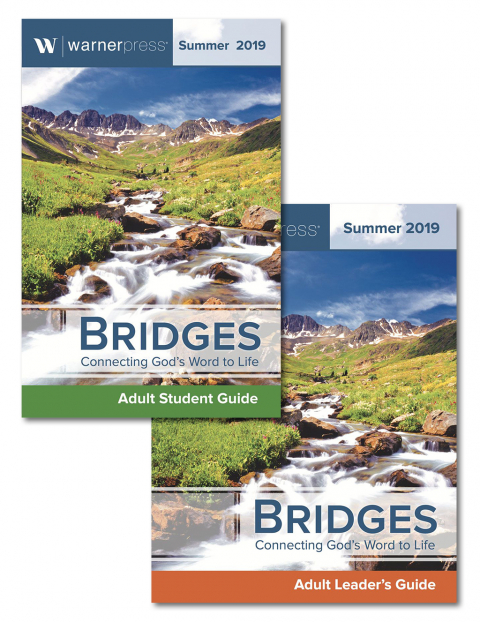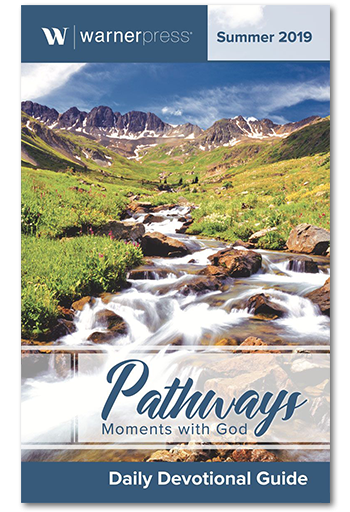“I meditate on your precepts and consider your ways. I delight in your decrees; I will not neglect your word.”—Psalm 119:15–16 (NIV)
What’s inside BRIDGES
Our popular Bridges Adult Curriculum features an easy-to-use format. Numbered step-by-step instructions and in-depth discussion questions guide students toward a deeper understanding of the Bible. This holiness-based curriculum is designed to encourage participation and discussion among students.


Connect
Begin the study with discussion or activities to connect group members with one another and the day's topic.

Study
Read and study the Bible passage. Background and commentary provide insights. Group questions spur discussion.

Apply
See exampes of how scipture has been applied in different situations by others.

Live
Prepare to live out in your own life what you have disussed.
Why do churches use BRIDGES?
✓ Traditional in-depth coverage of the Bible
✓ Easy-to-follow teaching instructions
✓ KJV & NIV translations included for both teacher & student versions
✓ Holiness based
✓ Questions enhance group discussion & participation
✓ Provides discipleship plan for adults to inspire spiritual growth & transformation

“BRIDGES has done wonders in our little church. It has changed lives.”
“All Scripture is God-breathed and is useful for teaching, rebuking, correcting and training in righteousness, so that the servant of God may be thoroughly equipped for every good work.” —2 Timothy 3:16-17 (NIV)
Be in God's Word every day with Pathways - Moments with God
Pathways—Moments with God is an ad-free daily devotional magazine. This quick devotional is convenient to read and study every day. Available in print and digital formats, Pathways works in conjunction with the Bridges Adult Curriculum, but can also be used independently. Bulk purchase rates are available! Makes a great gift.


Perfect gifts for seniors, military, college students

Room for notes, journaling, or prayer requests

Available in print and digital formats
How to Teach Bridges Online
Tools to Improve Your Small Group
Why Use Adult BRIDGES?
Why Use Adult BRIDGES?
By Arthur Kelly
One of the key reasons to use BRIDGES Adult Curriculum is found in the name itself. We all need help with the Bible. God’s Word was written over a long period of time, in many different locations, and by many different authors; sometimes it’s pretty difficult to figure out, even for the smartest of us. We all need help; we all need a bridge.
BRIDGES Curriculum builds bridges—bridges between you and the Scriptures; bridges between you and your classmates; bridges between you and the larger Christian and non-Christian world.
One of the central questions that we should all be asking ourselves often if not daily is this: In light of what I believe about God, the world, the church, others, and myself, how am I to live? BRIDGES builds bridges between your faith statements (what I believe) and how you live your life.
BRIDGES Curriculum doesn’t allow us to ignore the difficult passages, taking us only to the easy, feel-good ones. BRIDGES builds bridges between passages such as 1 John 4:7 that affirm us (“Dear friends, let us love one another…”) and passages such as James 1:2 that challenge us (“Consider it pure joy…whenever you face trials…”). We often want to avoid the tough and demanding stuff. BRIDGES builds bridges to help us look at and discover the truth of the Bible wherever we find it.
BRIDGES builds bridges that can carry us through our whole lives. BRIDGES builds a bridge to a place where we can safely explore our confusion and our insights with others. It is a systematic bridge carefully constructed to carry you through all of the Scriptures for all of your life.
BRIDGES builds a bridge to community and helps us to experience the body of Christ in fellowship with others who cross the same bridge but bring their own lenses, insights, and perspectives to the conversation.
BRIDGES builds bridges to life. The Bible is tough. It’s been around for thousands of years, attacked, challenged, argued over, questioned—yet, still it stands up to life and life’s challenges. And still people find meaning and hope and truth in it in the midst of the daily challenges they face, both personally and in community.
Much more than just a head study of the Bible, BRIDGES builds bridge to the heart. It offers devotional connection so that head and heart and hands are tied together to build the strongest bridge of all—a place where we are always safe to walk.
The Bible is God’s book. God is its hero; God is its subject. God speaks through the Word of God to reveal God’s heart and God’s desire. Perhaps most importantly, BRIDGES Adult Curriculum builds a bridge to God.
What's Your Learning Style?
What's Your Learning Style?
My therapist handed me a sheet of paper with several sketches. “Here are the exercises you’ll be doing after your knee replacement surgery,” she said. “Do you prefer to learn new activities by reading a sheet of instructions like this? Or should I tell you how to do each one?”
She continued, “I could move your knee with my hands, so you know how each exercise should feel. Muscle has memory. Or I can demonstrate each activity while you imitate what I’m doing.”
She had just outlined the four basic ways that each of us learns a new skill. Most of us rely on one of these learning styles, and when that method is not available, we find learning more difficult—or we lose interest.
This is true of any subject. Let’s say you want to memorize Psalm 23. If you are a visual learner, you might read the printed text over and over, hiding a verse at the end each time until you can recall the entire psalm. If you are an auditory learner, you might listen to someone recite or sing the psalm while you recite along. If you prefer to learn in tactile ways, you might illustrate the key ideas with doodles or a montage of photo clippings that serve as cues to your memory. If you are a kinesthetic learner, you might role-play the part of a loving shepherd who tends and cares for the flock.
A teacher can expect students with different learning styles to act differently in the classroom. They will respond differently to the same learning activities. Their ability to learn depends heavily on the learning activities offered to them. Here is a quick comparison of the four styles :
Visual. Students with a visual learning style…
• use lists and outlines to organize their thoughts.
• have active, creative imaginations.
• want the teacher to demonstrate or role-play a concept.
Auditory. Students with an auditory learning style…
• want the teacher to provide lectures and verbal instructions.
• enjoy discussions, dialogue, and debates.
• are easily distracted by noise and need a quiet place for study.
Tactile. Students with a tactile learning style…
• best retain information when they take
notes as they read or listen.
• like to doodle or draw while in class.
• want the teacher to provide hands-on activities for them (experiments, demonstrations, etc.).
Kinesthetic. Students with a kinesthetic learning style…
• are high-energy, active individuals.
• do not want to sit still to listen or read.
• prefer to do an activity themselves rather than watch someone else do it.
Good curriculum material provides activities for multiple learning styles. Regardless of the age of your learners, one size does not fit all. Some elderly learners are kinesthetic, while some preschoolers are auditory rather than visual learners, etc. To discover your own learning style, complete the free Index of Learning Styles Questionnaire at https://www.webtools.ncsu.edu/learningstyles.
How to Teach Lessons That Change Lives
How to Teach Lessons That Change Lives
What’s the goal of the class you teach or the small-group discussion you lead? You may have several: to worship God together, to impart knowledge of the Bible, to share spiritual insight, and so on. Suppose your goal is to change people’s lives. How might you do that?
Here are five methods you can use any time, with any curriculum material and any topic. They nudge learners to move beyond the biblical content of a lesson to ask, “How could this change my life?”
1. Focus on life application. This is essential to any Bible discussion. While it’s helpful to highlight the original meaning of biblical words, recent archaeological finds, etc., allow time for your learners to apply the text to their daily lives. I once asked each member of an adult group to read aloud one of the Ten Commandments and tell what it meant to them. One man read the sixth commandment and said, “I know what I must do tomorrow.” He said he needed to ask a co-worker’s forgiveness, because they’d had a heated argument in which this man had actually threatened his co-worker’s life. He confessed and apologized, the two men were reconciled, and their relationship was changed.
2. Pair your learners with someone from another generation. Some things are best seen through someone else’s eyes, so pair each adult in your group with a teenager or a child for your next discussion or field trip. Everyone will gain a whole new perspective on the world around them.
3. Build a spiritual autobiography. Ask group members to introduce themselves by telling the story of their spiritual lives—when they encountered God in special ways, when they made commitments to God, when they succeeded (or failed) in keeping those commitments, when God brought significant persons into their lives, etc. Give each learner an index card or a half-sheet of paper to outline his or her story, then collect them for future reference. As you study together in the weeks to come, invite group members to take out their outlines and imagine how that week’s new insight could help them continue their spiritual life stories.
4. Change your venue. A different setting can help your learners experience a subject in a memorable way. When a middle-school class met in a cemetery to discuss death and resurrection, several students pointed out grave markers of their relatives. It was a solemn yet inspiring experience. Perhaps you could meet in a soup kitchen, a hospital, or some other place related to your subject.
5. Role play. A simple role play gives your students a chance to see what might happen if they adopted a different attitude toward life. You don’t need to give them costumes or a script, just an impromptu suggestion: “Let’s pretend…”
For more ideas about life-changing lessons, see Discipleship that Transforms, ed. John H. Aukerman (Anderson, IN: Warner Press, 2013).

Copyright 2033 | Warner Press
